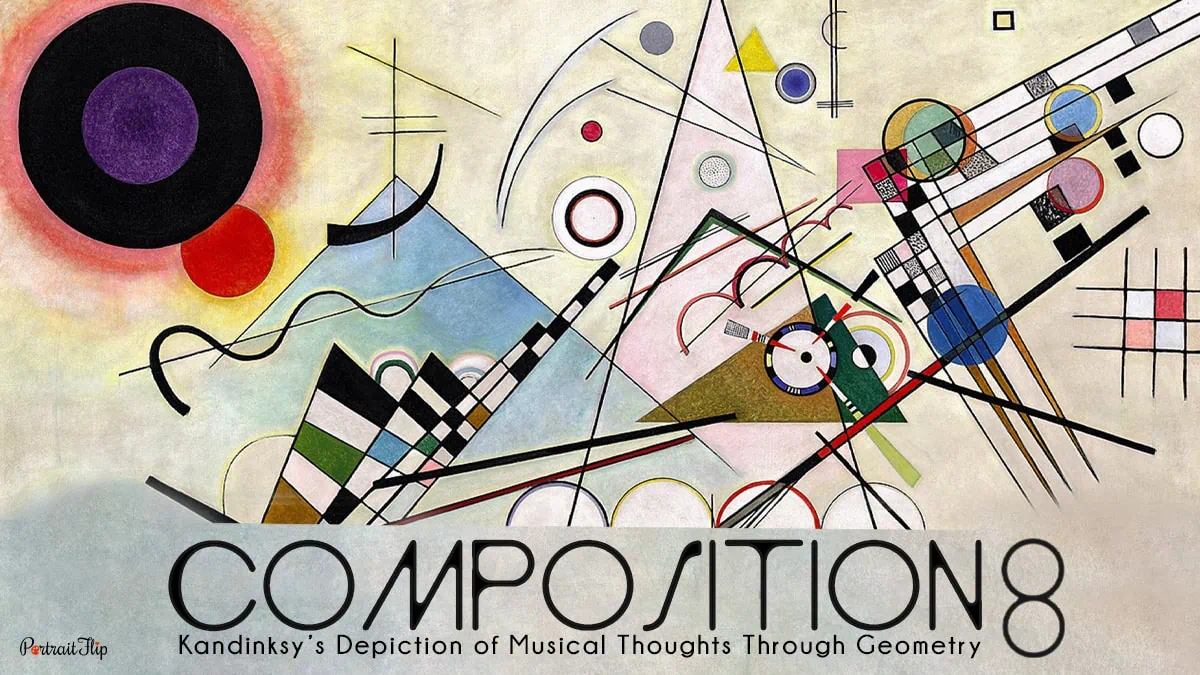Composition 8? Doesn’t it sound like a music sample to you?
Well, what if I told you that it is a painting by one of the leading abstract painters in history, Wassily Kandinsky?
In case you weren’t already familiar with that, you’d be surprised, just as I was when I first saw this enchanting masterpiece.
When you take a look at Kandinsky’s composition viii, you might get a bit confused about how to read the specific painting!
To this, I will say that when an artist creates a painting or artwork, they tend to create a piece that the viewers can relate to on a personal level.
As it is famously quoted in one of the book that I was reading online,
“The artist is not born into a life of ease and pleasure, with the right to live idly, avoiding all arduous duty.”
Kandinsky believed that artists should have a message to convey through their art.
And the ultimate goal should not be to convey their mastery but to convey their emotions!
The composition viii painting is a depiction of the same goal; he wanted to express what music looks like to him.
He has also given perspective to the viewers, trying to help them understand that whatever is going on around them is perfectly balanced.
So, without further ado, let’s get right into this beautiful masterpiece by Kandinsky, ‘Composition 8’.
Suggested Read: Famous Cubist Paintings
Table of contents
Introduction of Composition 8
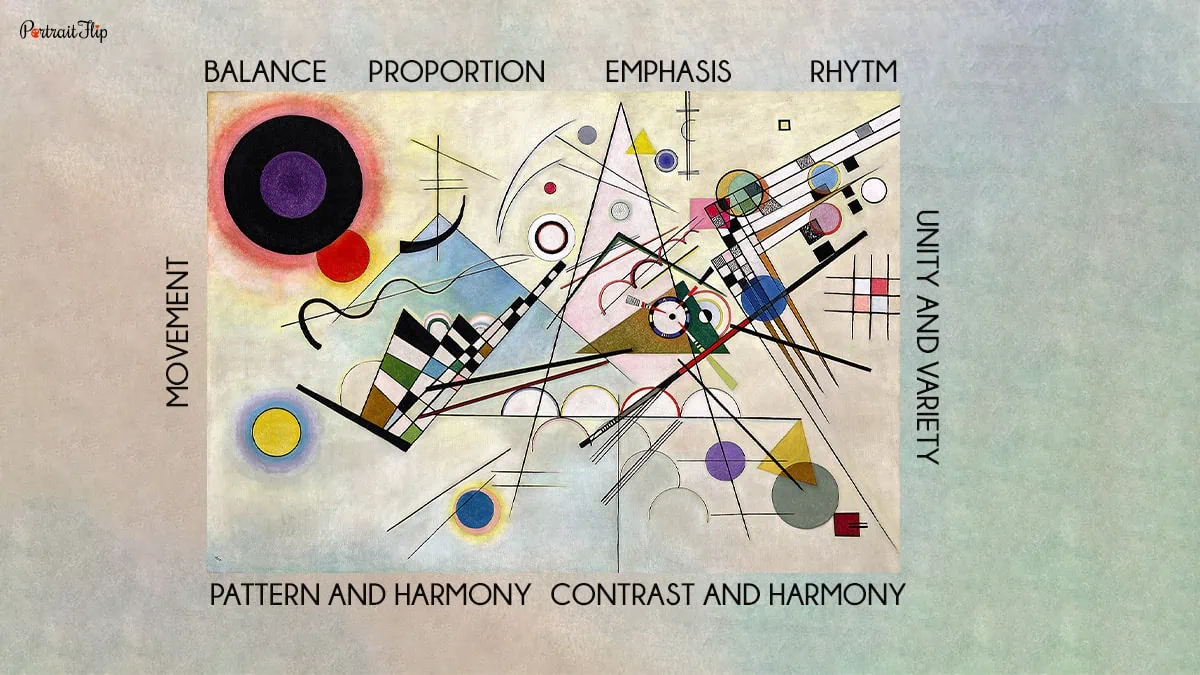
Before jumping straight to the Composition 8 painting, let us take a moment to understand what the meaning of composition in art is.
Well, composition in art is basically the arrangement and alignment of various elements within an artwork.
These elements cannot be placed in any vague way; the composition has to follow nearly eight principles.
Now that we have learned about the principles of composition, it is time to understand what was portrayed in the painting Composition by Wassily Kandinsky.
In composition viii, circles, triangles, and linear elements create an interactive surface for the subject to be portrayed.
This is a piece of art in which Kandinsky wants to portray his interest in music through geometry.
This composition viii was created by him after the war in 1923, which is why he regards this painting as his postwar achievement.
Composition 8 by Kandinsky has been marked by him as one of his greatest post war achievements.
Kandinsky was known to portray serious messages through shapes, elements, and structures.
Suggested Read: Composition VII by Wassily Kandinsky
About Kandinsky
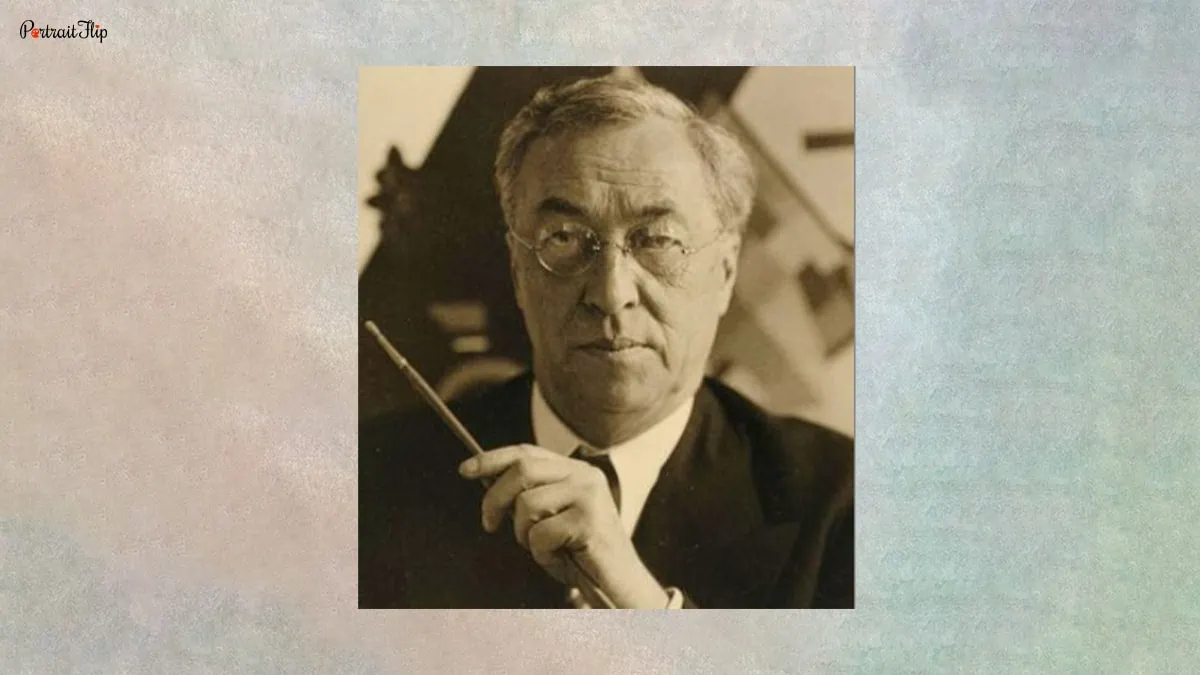
Wassily Kandinsky was born in Moscow, Russia, and he spent his childhood in Odessa.
He was an amazing person, an artist, and also a genius who was well-educated and was a professor back in the day.
He lived a pretty normal life and stayed away from controversies, and there are many famous Wassily Kandinsky facts that are not known in the mainstream.
He was a true painter at heart and was well-known in the art world.
On a mission to express what music sounded like through his paintings, Kandinsky devoted most of his time to learning new art forms and painting them.
Later, he enrolled at the University of Moscow and chose to study law and economics.
Kandinsky excelled in his life and career when he was offered a professorship at the chair of Roman law.
He started learning about the painting studies that included life-drawing, sketching, and anatomy at the University of Dorpat, at the age of 30.
In 1896, Kandinsky moved to Munich and studied at the school of Anton Azbe and further at the Academy of Fine Arts.
Moving ahead, he taught at the Bauhaus School of Art and Architecture from 1922 until the Nazis forcibly closed it in 1933.
He then moved to France, where he lived the rest of his life, becoming a French citizen in 1939.
Kandinsky unfortunately died at Neuilly-sur-Seine in 1944.
Suggested Read: Famous French Artists
Analysis of the composition
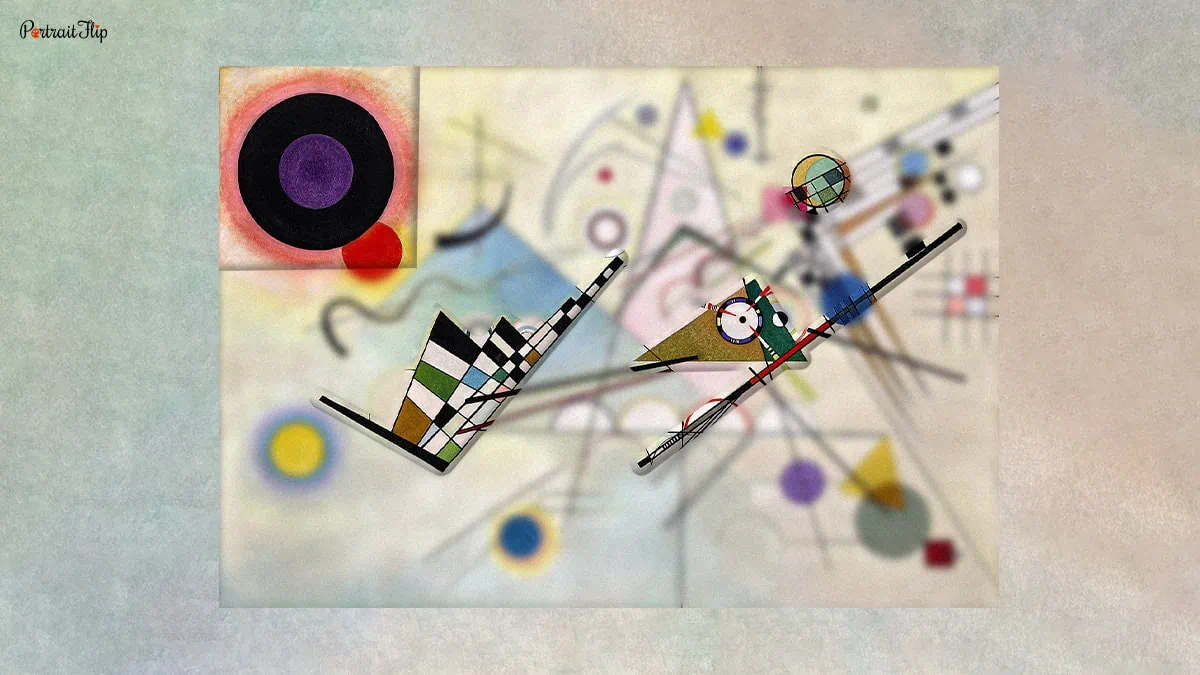
Kandinsky lived in Moscow for many years, and he learned a lot from their culture and later inculcated the learning in his art as well.
Being a poet by heart and a die-hard fan of music, Kandinsky created this painting named “Composition 8” as he was on his way to educate people.
He has used many elements in this composition that may seem vague, but they represent the depth of Kandinsky’s thinking.
Moreover, music has inspired Kandinsky’s art of abstraction in his paintings a lot!
For example, you might want to know what the shapes and symbols mean, so to brief you about it, I have done some research about composition 8 analysis.
In this specific painting, the use of circles is comparatively done in lesser ways, which played an important role in many of Kandinsky’s compositions.
In Kandinsky’s composition 8, the colors that he has used have the ability to tempt the viewers into connecting with their spiritual selves.
There have been many famous compositions in art, but the ones by Kandinsky always hold a special place.
Composition 8 by Kandinsky is his internalized vision of art in its abstract form.
This painting also denotes that there is nothing wrong with sticking to what you feel is correct and what is not.
It is more like a musical rhythm; your life may keep changing, and the change is mostly for the good.
This is the eighth painting in an art series, and it dates back to 1911, when Kandinsky co-founded the Blue-rider group in Munich.
The composition 8 by Wassily Kandinsky is a painting, and that was the closest he ever got to art in terms of expressing music.
Suggested Read: Paintings by Jackson Pollock
Texture and symbols in the artwork
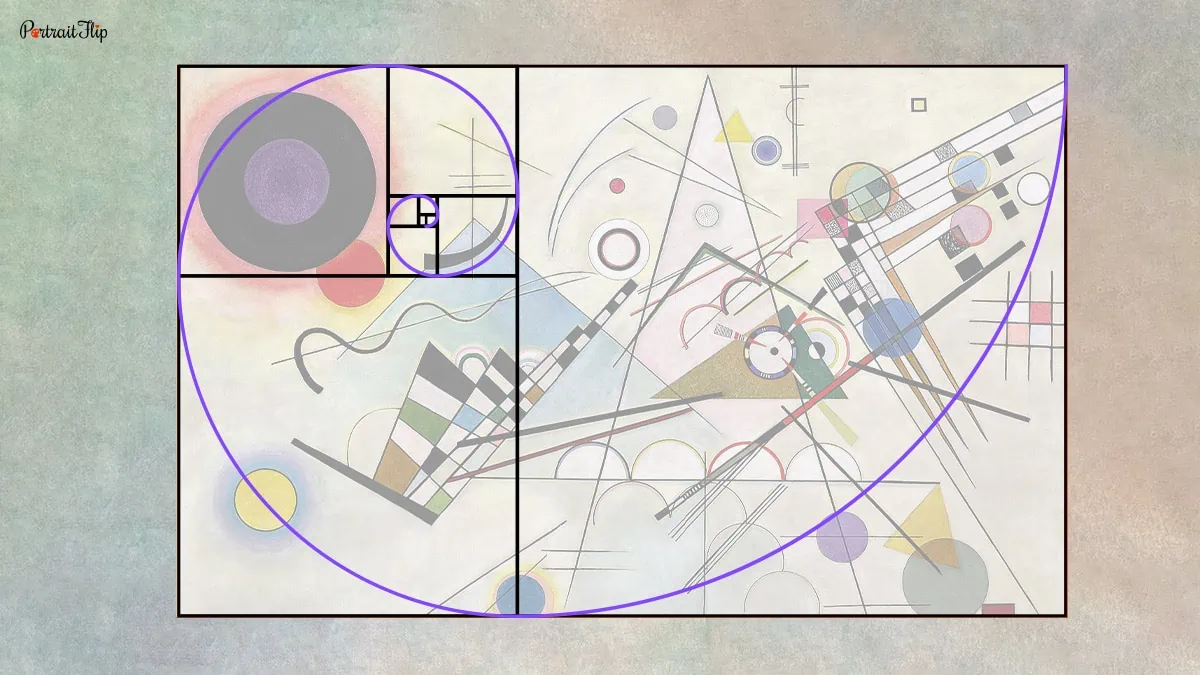
In composition 8, you can see that a rough base has been used under the oil paints to bring the texture to the viewer’s attention.
Compositions by Kandinsky made it to some of the most prestigious museums, and he also evoked some of the most human emotions through his art.
Kandinsky has effectively used lines, shapes, and circles to manage and maintain the rhythm and consistency of composition 8.
Being a fan of music, he always named his artworks after music theories like composition and improvisation.
Composition viii by Wassily Kandinsky revolves around a number of geometric elements and figures.
Also, the color palette that he has used pops up on the off-white background, which makes the composition look beautiful!
The color combination that Kandinsky has used represents a lot of warmer and brighter hues, which indicates that he has painted it with happy intentions.
Colors on Kandinsky’s canvas can be seen intertwining like musical chords in a harmony, which get followed by each other in a loop.
The lines and shapes create melodies that run into each other, thus creating a perfect balance of music and painting.
Viewing ‘Composition VIII’ is like listening to a piece of music in the blink of an eye, with the harmonies and rhythm all being played at the same time.
Suggested Read: The Sea of Galilee
Subject and the Depiction
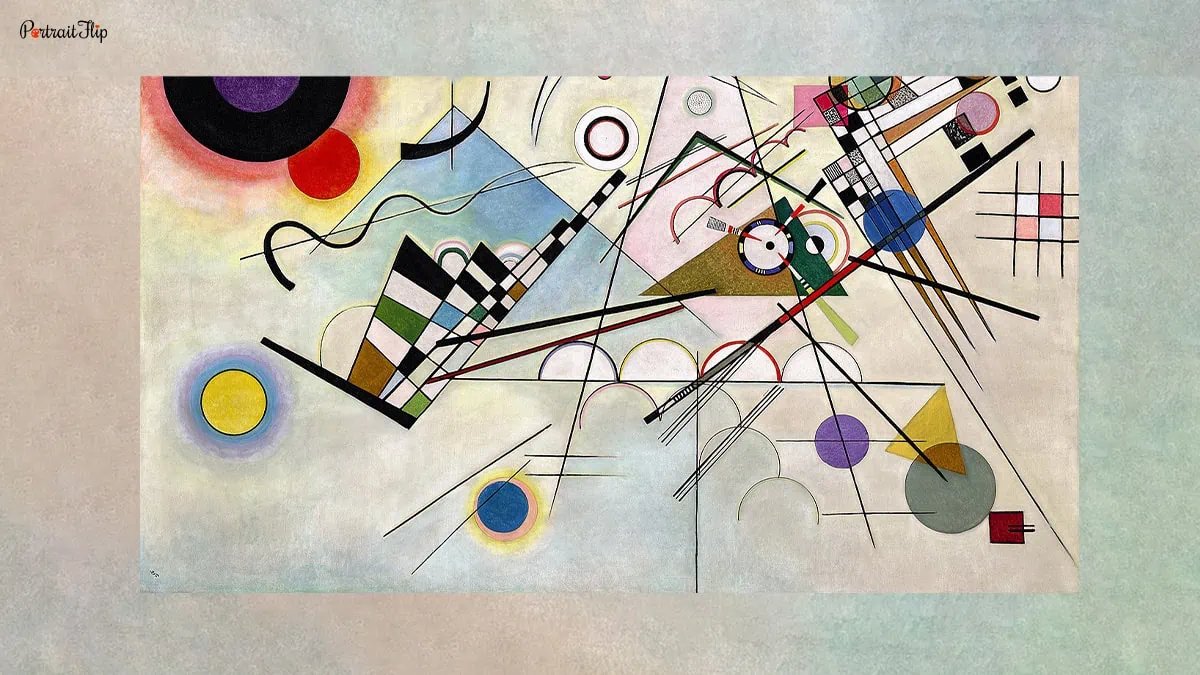
Composition 8 by Kandinsky offers an abstract contrast between calm and chaos through shapes and lines.
This painting received varied reactions from the viewers as well.
Kandinsky’s composition 8 consists of a variety of geometric shapes, colors, and straight-curved lines.
The straight lines that he has used represent the notes of the violin and the frets of the guitar, as well as hints at various instruments.
Kandinsky solely believed that the properties of geometric shapes with colors helped him express the chosen emotional impact for the viewers.
Also, on taking a closer look at the painting, you may also notice a compass in the middle of the canvas, which depicts that every step is a new direction.
The compass on art also denotes that you should keep moving ahead in your life, facing the challenges that may occur during the journey.
When you look at the painting “Composition 8,” what do you see?
You might say that this is an arrangement of shapes and symbols, but in a varied form.
You might say that it’s just some odd arrangements on a sheet of paper with different colors and shapes.
But let me tell you, this is the way Kandinsky thought to represent the sound of music.
If this interests you and you want to get it delivered right to you, then viola! We’ve got you covered!
You can now get a replica of Composition 8 made by industry-experts at affordable prices.
Kandinsky and Abstract Art

Wassily Kandinsky is one of the most influential abstract artists in the history of the art world.
The analysis of the compositions by Kandinsky depicts that simple ideas can also lead to complex masterpieces and vice versa.
He has been working on his own art alongside the works of other artists as well.
According to Kandinsky, even a simple artwork, which may look like it has nothing to offer in terms of information to the viewers, is still one of the most engaging art pieces.
He mentioned that, line is the foundation of all drawings that can be used to suggest shape, pattern, form, etc.
And many more elements were described by him during his abstract period, and when he painted composition 8, the art world was introduced to the new depths of abstract form.
These were a few important keynotes by the artist Kandinsky on the form of abstract art.
Suggested Read: Abstraction of Art: The Movement
Conclusion
This was about the masterpiece that was created by the prodigy Kandinsky.
Does composition VIII’s painting tempt you to get one or more artworks by Kandinsky?
I mean, wouldn’t you like a well-framed masterpiece by Kandinsky hanging in your living room?
And we assure you that the replica of your selected artwork is handmade to perfection and will be worth-it all!
Explore paintings on our website and also check out the offers currently running on our platform.
Surprisingly! You can get a replica made for yourself, too, by our professional artists.
So, what are you waiting for? Take a look at:
Author’s Note
Thank you so much for reading our article on Composition 8!
I am glad that you stayed and read this article about “Composition VIII,” a painting by Wassily Kandinsky.
So, with this being said, I would like to request that you share this blog as much as you can and also leave your valuable feedback in the comments section.
We thrive on bringing new things in-store for you, and we are glad that we are able to provide you with the same.
To know more about what’s new at PortraitFlip, make sure that you follow us on our social media accounts: Instagram, YouTube, and Pinterest.
Meanwhile, take care, folks!
See ya.
FAQs
Wassily Kandinsky has used both abstract art and suprematism to create Composition 8.
Composition 8 by Wassily Kandinsky is an oil-on-canvas painting that is 140 cm in height and 201 cm in width, i.e., 55.1 inches by 79.1 inches.
Composition 8 by Kandinsky represents his highest post war achievements, and he has also tried to hint to the viewers about what he wanted to achieve.
Composition 8 by Wassily Kandinsky is located in the Solomon R. Guggenheim Museum in New York City.



